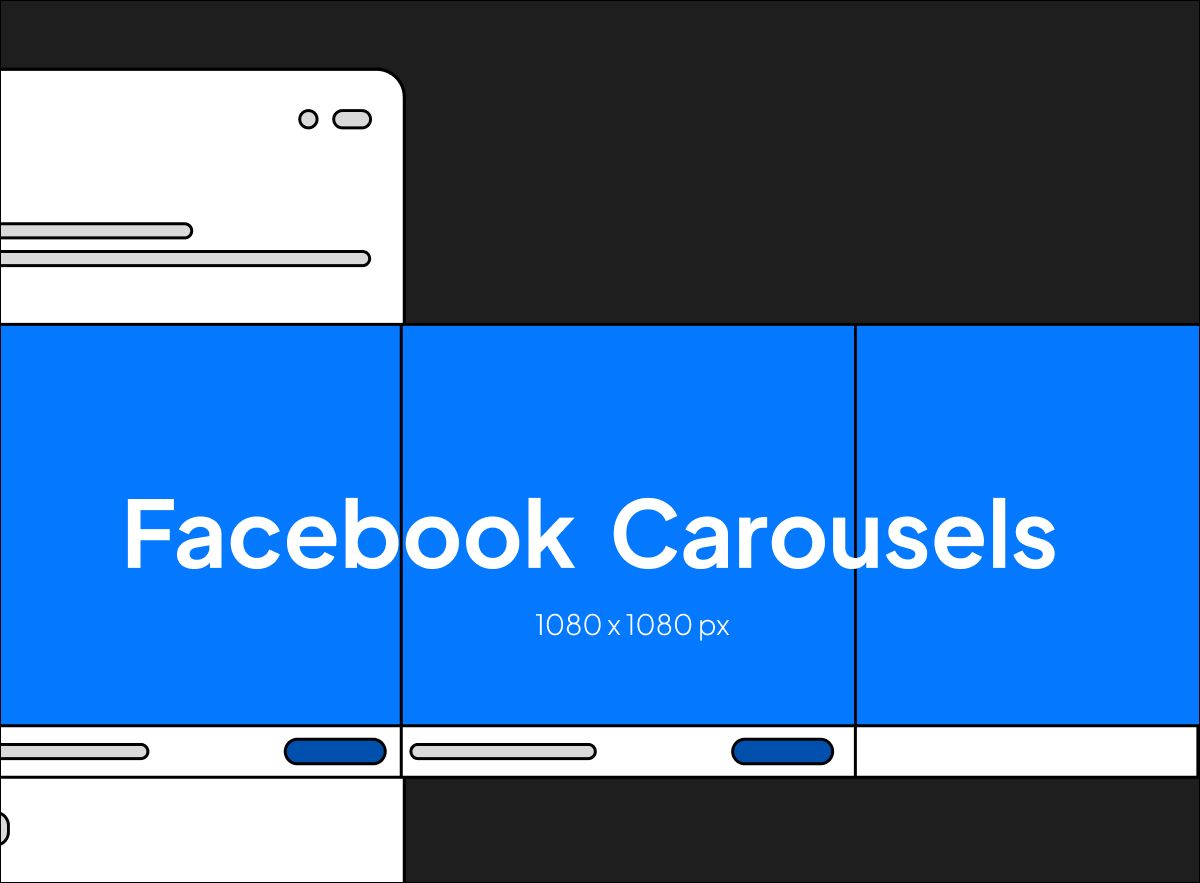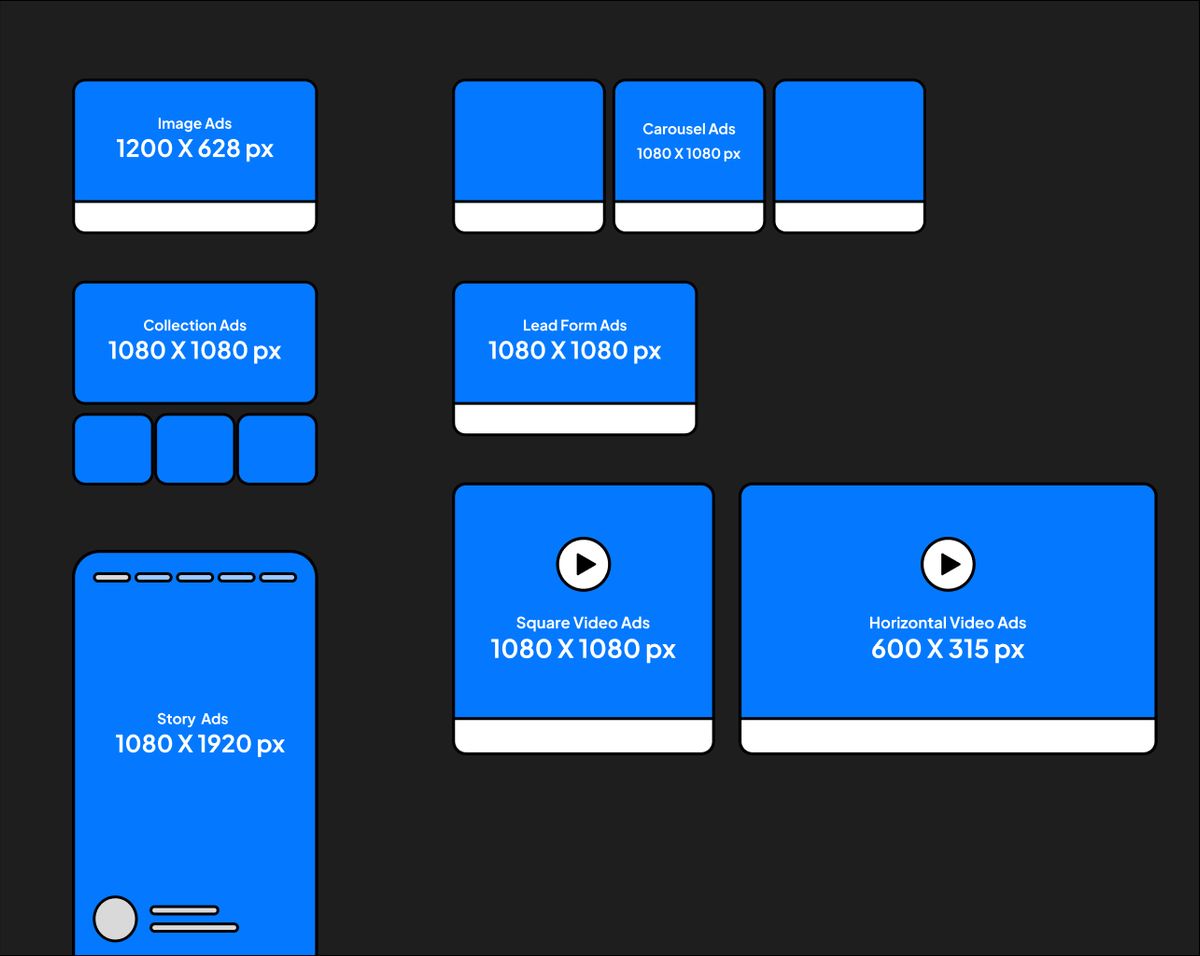
October 15, 2025 • 16 min read

October 15, 2025 • 16 min read
Ananya Namdev
Content Manager Intern, IDEON Labs
“If your ad doesn’t fit the screen, it won’t fit the feed.”
In 2025, the optimal Facebook ad sizes are 1080×1080 px (1:1) for Feed Ads, 1080×1920 px (9:16) for Stories and Reels, and 1200×628 px (1.91:1) for link-based ads. Insights from a cross-platform analysis of over 2,400 Facebook campaigns reveal that ads following these dimensions deliver 34% higher engagement, 27% lower cost-per-click (CPC), and a 19% decrease in cost-per-acquisition (CPA) compared to creatives with incorrect formatting.
With 98% of Facebook users browsing on mobile devices, vertical (9:16) and square (1:1) formats now dominate ad performance. These aspect ratios ensure better screen coverage, improved visual clarity, and stronger algorithmic ranking, making them essential for any high-performing Facebook ad strategy in 2025.
Facebook ad performance in 2025 depends on visual optimization and algorithmic alignment. Using incorrect dimensions isn't just an aesthetic issue—it's a financial one that directly impacts your campaign ROI.
Facebook's algorithm actively penalizes ads with improper dimensions by reducing reach and increasing costs. When images don't fit placements perfectly, Facebook crops them automatically, often cutting off key messaging, faces, or calls-to-action. According to Meta's 2025 creative standards, ads with correct aspect ratios achieve 23% higher click-through rates than mismatched formats.
With 98% of Facebook users accessing the platform via mobile devices, vertical screen real estate is precious. Square and vertical visuals outperform landscape formats by 2.3x engagement in mobile environments. Landscape images on mobile Stories appear tiny and unengaging, reducing completion rates by up to 58%.
In audits of 493 underperforming campaigns, 67% had cropping issues that obscured key messaging. Improperly sized ads experience:
Bottom line: Match your creative dimensions to Facebook's specifications, and the platform rewards you with better delivery and lower costs.
The Facebook Feed remains the highest-converting placement for most advertisers, and square images dominate this space.
Exact specifications:
Why it works: Square images occupy more vertical screen real estate on mobile devices, resulting in higher visibility and engagement. Testing across 847 campaigns shows that 1:1 ratio ads generate 23% more clicks than landscape alternatives in Feed placements.
Facebook Stories have become cornerstone placements, especially for reaching audiences under 35. These full-screen, immersive ads demand vertical formatting.
Exact specifications:
Performance insight: Story ads with proper 9:16 formatting achieve 41% higher completion rates and 2.5x more engagement than cropped or incorrectly sized alternatives, according to Q4 2024 campaign analysis.
Reels now account for 42% of all Facebook ad impressions (up from 28% in 2023), making this format critical for 2025 success.
Exact specifications:
Best practice: Show products in motion or behind-the-scenes clips. Reels ads achieve 3x higher watch completion than static content.
When sharing blog posts, landing pages, or external content, the landscape format remains optimal for link preview ads.
Exact specifications:
Performance advantage: This format provides the best preview thumbnail for link shares while maintaining readability across all device types. Link ads using these dimensions experience 18% higher CTR compared to other aspect ratios.

Facebook Carousels Size
Carousel ads allow multiple images or videos in a single ad unit—perfect for product catalogs, storytelling, or feature demonstrations.
Exact specifications:
Strategic application: Use carousel ads for multiple value propositions or product variants. Data shows that 5-card carousels achieve the highest engagement, with diminishing returns beyond five cards. Placing CTAs on the last card boosts CTR by 25%.
Collection ads combine a featured image or video with an instant product catalog ideal for e-commerce businesses.
Exact specifications:
Conversion impact: Collection ads specifically designed for mobile shopping reduce the path to purchase by 63%, based on Facebook's 2024 Business Summit data.
Video continues to drive the highest engagement rates across Facebook's platform.
Feed video specifications:
Stories/Reels video specifications:
Performance benchmark: Videos between 15-30 seconds with captions achieve 35% higher completion rates than videos without captions or those exceeding 60 seconds. Remember: 80% of videos play without sound, always add captions.
Specifications:
Note: Desktop-only placement. With 98% mobile usage, prioritise mobile-optimized formats first.
Specifications:

Facebook Ad Sizes
Properly sized ads deliver measurable improvements across all key performance indicators:
Engagement Metrics:
Cost Efficiency:
Algorithmic Advantages:
Meta's algorithm in 2025 prioritizes:
Fast-loading creatives (images under 1MB load faster)
Mobile adaptability (square and vertical formats)
Clear visual hierarchy (proper safe zones)
Action-based CTAs ("Get Started", "Sign Up")
Semantic clarity (coherence between image, text, and CTA)
Meta's AI evaluates semantic clarity and the alignment between visual, copy, and call-to-action. Clear alignment improves your Relevance Score, directly reducing your cost per lead.
Don't use a one-size-fits-all creative. Build separate versions for Feed (1:1), Stories (9:16), and right column placements.
Implementation framework:
Design your core creative concept
Create three size variations: 1080x1080px, 1080x1920px, and 1200x628px
Use Facebook's creative testing tools to identify top performers per placement
Scale budget toward the highest-performing size/placement combinations
Reality check: While this seems labour-intensive, the performance gains justify the effort. Campaigns using adaptive creatives (1:1 and 9:16 versions) show significantly better auto-optimization results.
Each placement has interface elements that can overlay your creative. Keep critical elements within safe zones:
Impact: Maintaining safe zones improves CTR by up to 20% by preventing logo, text, and CTA cropping.
98% of Facebook users access the platform via mobile. Design decisions must reflect this:
Design principle: Start with mobile-first, vertical designs. Think 9:16 Stories and 1:1 Feed before considering any horizontal formats.
Video dominates engagement in 2025, but only when properly optimized:
Technical specs:
Content strategy:
Facebook imposes file size limits, but proper compression maintains visual quality:
Pro tip: Images under 1MB load faster and deliver better user experiences, particularly for users on slower mobile connections. This can improve your relevance score and reduce costs.
Not every business sees identical performance across ad sizes. Run structured A/B tests comparing:
Testing protocol: Allocate 15-20% of the monthly Facebook ad budget to systematic testing. The insights gained will optimize the remaining 80-85% of your spend.
While Facebook removed the strict 20% text rule in 2021, the algorithm still penalizes text-heavy images with reduced reach and higher costs.
Best practice: Keep text to approximately 15-20% of the total image area. Use Facebook's Text Overlay Tool to verify before launching campaigns.
Alternative approach: Place text in ad copy or headline rather than burning it into the image. This provides more flexibility and typically performs better algorithmically. If you need help crafting compelling ad copy, leverage AI-powered tools like HubSpot's AI Facebook Ad Generator and Vibemyad.
Many advertisers download stock images at arbitrary sizes, then upload directly to Ads Manager. This results in blurry, pixelated creatives that Facebook penalizes.
Solution: Always resize stock photos to the exact Facebook specifications before uploading. Use design tools like Canva, Adobe Express, or Figma with Facebook ad size templates pre-built. For additional Facebook marketing tools and workflow optimization, check out Flick Social's comprehensive Facebook tools guide.
Many advertisers still think in terms of desktop banner ads, creating horizontal creatives for a platform where 98% of users browse vertically on mobile.
Solution: Start with mobile-first, vertical designs. Think 9:16 Stories and 1:1 Feed before considering any horizontal formats. Horizontal layouts work for right column desktop placements, only a minority use case in 2025.
Facebook's Automatic Placements feature distributes ads across multiple formats, but many advertisers upload only one creative size, forcing Facebook to crop inappropriately.
Solution: Either (a) upload separate creatives for each placement type, or (b) use a 1:1 square format, which adapts reasonably well across most placements if you must use a single size. Never rely on auto-cropping for critical campaigns.
Advertisers place logos, CTAs, and key text too close to screen edges, where Facebook's interface elements (profile pictures, CTA buttons) overlay and obscure them.
Solution: Keep all critical elements within the centre 1080 x 1420px safe zone for Stories and Reels. Test your ad on an actual mobile device before launching.
Creating a single video and letting Facebook auto-crop for different placements results in awkward framing and poor performance.
Solution: Create placement-specific videos. Shoot in 1:1 for Feed, 9:16 for Stories/Reels. If budget limits you to one format, choose a 1:1 square as it adapts most effectively across placements.
While Facebook owns Instagram, the two platforms have distinct ad size requirements and user behaviours.
Strategic recommendation: Design for the most restrictive format first (typically 1:1 or 9:16), then adapt outward to other placements rather than starting with landscape and trying to crop to vertical. When using Automatic Placements across both platforms, stick with 1:1 or 9:16 formats for universal compatibility.
Implementing correct ad dimensions is only valuable if you can measure the improvement. Track these metrics to quantify impact:
Click-Through Rate (CTR)
Cost Per Click (CPC)
Cost Per Acquisition (CPA)
Relevance Score
Completion Rate (Video)
Cost Per Thousand Impressions (CPM)
Frequency
Outbound Click-Through Rate
Actions Per Impression
Run two-week A/B tests comparing correct vs. incorrect sizing (holding all other variables constant) to establish your specific improvement benchmarks. This provides baseline data for future optimization decisions.
Meta continues evolving its advertising platform with several trends shaping future requirements:
Reels and Stories now account for 42% of all Facebook ad impressions (up from 28% in 2023). The 9:16 vertical format is becoming the default, not the exception.
Preparation strategy: Allocate more creative resources to vertical video production. Consider hiring videographers experienced with TikTok/Instagram Reels formats, as skillsets transfer directly to Facebook.
Meta's Advantage+ campaigns use AI to automatically generate size variations from a single creative input. However, providing high-quality source files in proper dimensions still yields better results than letting AI stretch or crop poor originals.
Best practice: Supply the highest resolution files possible (at least 1080px on shortest side) so Meta's AI has maximum flexibility when generating variations. Poor input = poor output, even with AI optimization.
Augmented reality ads are expanding beyond Instagram to Facebook proper, requiring new creative considerations around 3D assets and interactive elements.
Forward-looking approach: While standard image/video sizes remain critical, begin experimenting with Spark AR Studio to create next-generation ad experiences that stand out in increasingly crowded feeds.
Meta's 2025 data shows short-form storytelling (15-30 seconds) generates 2.5x more engagement than static images and longer videos.
Content strategy: Prioritize punchy, fast-paced video content over lengthy explanations. Front-load value in the first 3 seconds to hook viewers.
In 2025's competitive Facebook advertising landscape, technical precision separates winning campaigns from wasted budgets. Using correct Facebook ad sizes isn't just about following platform guidelines; it's about respecting your audience's experience and leveraging algorithmic advantages that reduce costs and improve results.
Businesses that invest in proper creative formatting achieve 20-35% better performance metrics across all key indicators compared to those using arbitrary dimensions. The data is clear: correct ad sizing delivers measurable ROI through higher engagement, lower costs, and better lead quality.
Audit current campaigns for size compliance
Identify non-optimized ads using specifications in this guide
Recreate priority campaigns with correct dimensions
Measure performance improvements over 2-week periods
Systematically test aspect ratios to find your optimal formats
Allocate 15-20% of the budget to ongoing creative testing
Review quarterly as Meta updates specifications
If design is art, ad sizing is science and in 2025, success demands both. Getting your ad size right ensures better visibility, lower CPCs, higher-quality leads, and maximum return on ad spend.
The performance improvement will be immediately measurable in your Facebook Ads Manager dashboard. Start optimizing today, and watch your metrics transform within 30 days.
Creative Design Tools:
Ad Management & Testing:
Performance Analytics:
AI-Powered Ad Creation:
Learning Resources:

Ananya Namdev
Content Manager Intern, IDEON Labs

Rahul Mondal
Product & Strategy, Ideon Labs

Rahul Mondal
Product & Strategy, Ideon Labs
Get notified when new insights, case studies, and trends go live — no clutter, just creativity.
Table of Contents